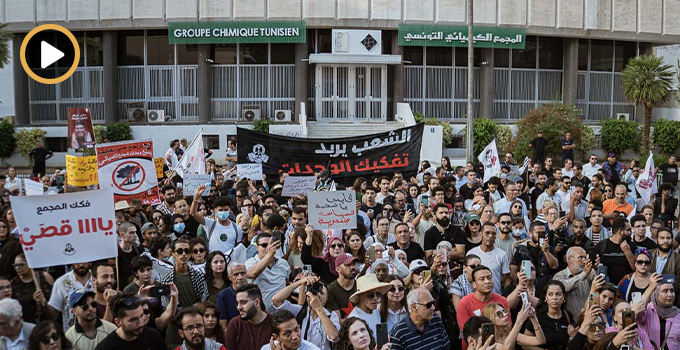The devastating consequences of wildfires are not limited to environmental damage. The repercussions are also economic, entailing significant financial losses, as well as social, with the nearly one million inhabitants of forest areas suffering a grave threat to their livelihoods. Faced with the issue, and in spite of regular ministerial council meetings held within the different departments concerned, the state has proven incapable of controlling this scourge which has only grown worse year after year.
As the season of heat waves draws near, many are haunted by memories of wildfires. The denizens of forest regions have still not recovered from the ravaging blazes which consumed hundreds—and in some cases thousands—of hectares of forest land stretching across the west and north of the country. These fires pose a major threat to towns and hamlets nestled in the outskirts of forests, and constitute an overwhelming adversary for Civil Defense teams which required outside logistical support in order to contain several hotspots that erupted in the midst of heat waves, strong winds and drought.
A RECURRING NIGHTMARE
Civil Defense teams recorded 693 forest fires during the summer of 2023. This number is no exception; different data published by the National Institute of Statistics (INS) and the General Directorate of Forests (DGF) reveal an increase in the number of wildfires and the surface area of affected zones over the past decade. The number of fires increased from 400 in 2012 to 458 in 2021, while the surface area impacted rose from 2,400 hectares to 25,808 hectares over the same period.

Beyond the damage caused to cereal crops (with losses equal to 1.2 million dinars in 2019, for instance), all forests stretching from the governorate of Bizerte in the north-most tip of the country, to the governorates of Beja and Kef in the northwest, and still others in the center and northeast—have been impacted. Covering approximately 4.5 million hectares, or 34% of the country’s total surface area, this stretch of forest is home to nearly one million Tunisians and constitutes their primary source of income. According to data provided by the government’s Civil Defense department, 50 wildfires recorded during the summer of 2023 destroyed 1,777.65 hectares of land.
And yet the state has proven incapable of mitigating the surge in wildfires, or of repairing the damages caused by them, particularly in forests. As the surface area of lands ravaged by wildfires increases every year, reforestation campaigns have decreased significantly. Between 2009 and 2017, the surface area of reforested land dropped from 11,249 hectares to 2,601 hectares. The main government body charged with preserving plant cover appears unable to fulfill its role due to a lack of means, which authorities have been reluctant to remedy. The General Directorate of Forests is greatly understaffed, with a mere 7,500 forest rangers currently serving out of the required 13,300. Every ranger is therefore responsible for 2,000 hectares of land.

Besides a lack of personnel, the DGF has witnessed an overall aging trend throughout its administration, notably among those who work in the field. This is compounded by the non-compensation of retired employees ever since the suspension of allocations for civil servants under the Finance Law of 2016. Other handicaps which limit the sector’s development: a lack of training in the use of modern means of communication, the absence of a special status for forest rangers who neither benefit from protection nor free health care in case of injury on the job. In its evaluation of the response to wildfire once they have started, the Annual Performance Report on the Mission of Agriculture, Water Resources and Fishing from 2022 mentions numerous obstacles, the most important of which is challenging coordination among the Civil Defense department, the National Committee Against Disasters, and regional services. Other limitations include a lack of human resources, in particular technicians, fire fighters and machine operators. The Ministry furthermore points to a lack of machinery (excavators, bulldozers and carriers); limited funding in the scope of annual allocations for infrastructure works and projects to prevent fires; the dilapidation and constant breakdown of the current communication network; the impossibility of intervention in closed military zones which facilitates the propagation of fire in surrounding areas.

SOURCE OF IMPOVERISHMENT
Although less visible than the environmental damage which wildfires leave in their wake, the economic repercussions are no less dramatic. Tunisia’s forests are a source of unsuspected wealth and productivity, accounting for 14% of the country’s agricultural GDP, 1.4% of the national GDP, and 14% of energy economies. Forest revenues amount to about 20 million dinars annually, with 10 to 15 million dinars in the form of direct revenues for the National Treasury. These revenues are primarily earned from different wood varieties, whose production is about 177 m3 of wood harvested in 2021, in addition to wild varieties of medicinal and aromatic plants which cover a surface area of 409,000 hectares. Tunisia ranks 32 globally in the exportation of vegetable oils, which bring in upwards of 30 million dinars annually.
On just one hectare of land, the losses caused by wildfires cost between 20,000 to 50,000 dinars. The reforestation costs about 9,000 dinars. It takes 20 years for trees to regenerate after a wildfire.
These statistics illustrate the economic value of forests, both for the state as well as for the denizens of forest regions. The majority of these populations live in situations of socio-economic vulnerability and find themselves deprived of an extra source of income with each hectare of land that goes up in flames.
Even more telling is the data that we were able to confirm with certain delegations whose economic activity is almost exclusively forest-related. For example, the rate of poverty in Sejnane (Bizerte governorate) is 39.9%. In the delegation of Nefza (Beja governorate) and Ain Draham (Jendouba governorate), this rate is 37.7% and 27.2% respectively. These numbers do not vary much across other delegations adjacent to forests, where 9% of the country’s total population resides. Their hardships are exacerbated by wildfires and the state’s negligence.
For more insight on the economic repercussions of wildfires, Nawaat contacted Ali Mastouri, owner of the company Sanabel Al-Chamel for Social and Solidarity Economy. The latter is part of an ecotourism project involving dairy goat farming and cheese production in the Cap Negro region (Nefza delegation, Beja governorate).
Referring to a report published by the General Directorate of Forests in Beja, Mastouri highlights the vast surface area and importance of forests in the governorate. Covering 110,000 hectares, forests make up 30% of the governorate’s total surface area and 9% of the country’s forest lands. 60% of forests are concentrated in the north of the governorate, in the delegations of Amdoun and Nefza, and are home to a diverse plant cover composed primarily of oak cork, Aleppo pine, hazelnut, Eucalyptus and Acacia. Beyond this, an estimated 63,000 hectares are covered in maquis, shrubs and forest terrain. All of these products contribute a total of 1.5 million dinars to the state’s general budget in the form of direct revenues.

Between two infernos
Mastouri emphasizes that this natural wealth constitutes a livelihood for local populations, an estimated 80,000 people. Forest land and resources provide these individuals with 15 million forage units for their livestock, in addition to employment for 2,500 or so cork harvesters. The development of ecotourism over recent years has also helped generate employment. In Mastouri’s words:
When fires devastate dozens of hectares each year, the region’s economic activity is severely affected. This is especially true for livestock farmers who lose free pasture land which helps them save on the costs of concentrated feed and enables them to bring in a bit of extra income. The same is also true for those who harvest cork, pine and other forest products which are consumed by wildfires every year, causing severe economic loss for an already vulnerable segment of the population.
Ali Mastouri
Questioned about the state’s presence and role in this issue, Mastouri replies that authorities ignore or pretend not to realize the magnitude of the catastrophe that has befallen the denizens of forest regions, and does not go beyond promise-making or doling out in kind compensation when disaster hits. As an example, he points to the so-called Forest Landscapes Project [1] which remains inoperative since its official launch on October 5, 2018. At the time, Mastouri recalls, the government of Youssef Chahed lavished out promises to the populations inhabiting forest regions, but followed up on not a single one. He says that ensuing frustration has led some to carry out acts of violent protest by setting fire to their own forests. Besides climate change and negligence, such acts are, in fact, another cause of forest fires.
Whether sparked by criminal activity or climate change, fires are devouring the natural wealth of Tunisia’s northwestern forests. The state’s incapacity to protect this economic resource and recognize its potential has left local populations between two infernos: devastating wildfires on one side, and extreme poverty on the other.
[1] The integrated landscape management project in the least developed regions of Tunisia, called the “Forest Landscapes Project,” was officially launched on October 5, 2018. Resources were mobilized to cover its cost, an estimated 269 million dinars, thanks to a 227 million dinar loan from the World Bank and 42 million dinars in self-financing. The project is based on a philosophy which aims to achieve the principle of integrating agricultural, forest and pastoral systems in priority regions across eight governorates: Bizerte, Beja, Jendouba, Siliana, Kasserine, Sidi Bouzid, Kef and Kairouan, including 18 delegations and 25 landscapes units across 400,000 hectares.





iThere are no comments
Add yours